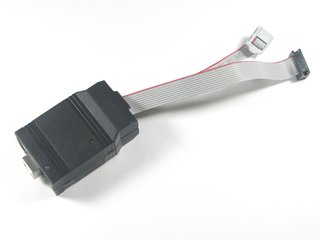Peggy 2LE Light Emitting Pegboard kit
The display can run off the included ac adapter, and is designed to drive as many LEDs as you care to solder into the holes. The board can accommodate LEDs in any color and in several of the most common sizes, including 3 mm and 5 mm (standard T-1 3/4 size).
Kit Options and Configurations
This is an open-source project. In keeping with that spirit, we are offering these kits and the parts for them in different configurations for flexibility.
- The Peggy 2LE Kit itself includes the circuit board, preprogrammed microcontroller, plug-in power supply, LED driver chips, high-current transistors, power switch, two buttons, rubber feet and all other components needed to make the pegboard display base, along with full color printed instructions. Just assemble, and add LEDs and power. The power supply is a "univeral input" type that accepts worldwide voltage input. (A simple plug adapter may be needed if you live outside north america.) An international multiplug power supply that connects to worldwide power without need for additional adapters is available separately here and its appropriate jack is here.
- Option: LED Bundles! A matched 640 pack of ultrabright LEDs in 5 mm packages, with either clear or diffused lenses, in various colors. Enough to fill up the Peggy with a few spares. Matched sets like these are recommended if you plan to fill *every* LED location with an LED and want a uniform-looking display. (Otherwise, "Mix and Match" LED Selections can be found here.) A discount applies when you bundle a 640-LED pack with your Peggy 2LE kit.
- Option: Extra button pack. A package of five extra miniature tactile button switches that you can add to your Peggy. Could come in handy if you're reprogramming Peggy to be a game. Four arrow keys and a "fire" button? Available here.
- Option: Programming interface. To reprogram your Peggy, you'll need some sort of interface. For Arduino-style programming (which we recommend), we offer the Adafruit FTDIfriend.
What's New in Peggy 2LE?
Peggy 2LE supports the same basic functionality as the larger Peggy 2: it drives up to 625 LEDs of up to 5 mm size. Still open-source and hackable. Arduino compatible. Code-compatible with Peggy 2-- every Peggy 2 program can run on the Peggy 2LE. The main differences between the two are:
- Peggy 2LE is smaller-- about 1/4 the size, designed to fit smaller LEDs.
- Peggy 2LE does not have a battery box. You can still use batteries if you want to (3xD cell) but a holder is no longer provided. Instead, we include the AC adapter.
- Peggy 2LE does not have the breadboard-style prototyping area on board. (Did we mention that it's smaller?)
Hardware serial port option
Peggy 2LE can optionally be built with a hardware serial port. What used to be a tricky hack is now supported with a simple wiring change, just as on the current version of the Peggy 2. If you build it this way, you can use the serial port while running the display, and you can use it to send or stream data or images to the Peggy. (Note that the pins used to replace the serial port otherwise go to the I2C interface and to button b5 on the PCB. So, you'll need to choose between I2C and Serial.)
Printed circuit boards
The centerpiece of this kit is a beautifully made printed circuit board. It is 9.625x5.9" (245x150 mm) in overall size, two-sided with plated through holes.
The board is manufactured with black epoxy soldermask on both sides for high visual contrast, and component locations are labeled on the top side of the board with a white silkscreen. The boards are RoHS compliant (lead free), manufactured to UL 94V-0 standards, and fully electrically tested. Mounting holes are provided at all four corners. Multiple Peggy 2LE boards can be set side by side to have a visually continuous field of LEDs without gaps between them.
Building it
Peggy 2LE is sold as a soldering kit [?]. Basic electronic soldering skill is required, and you provide basic soldering tools: a soldering iron + solder and small wire clippers. No additional knowledge of electronics is presumed or required. Easy "through-hole" construction and clear, full-color printed instructions. Assembly time: 1-2 hours plus time to solder the LEDs themselves. An extended introduction to the project and its design is available here.
Programming it
Peggy 2LE comes pre-programmed with a routine that lights up all the LED locations, so you can make a basic LED sign or display without any programming.
Of course, Peggy 2LE is designed to do a whole lot more, and we strongly recommend all users to have a programming cable available. The easiest way to get started is through the Arduino software environment, for which you will need a USB-TTL interface. You can download the Peggy2 Arduino Library (along with several example programs) here. The library is an evolving open source project and your own code contributions are welcome.
You can find a list of Peggy 2 and Peggy 2LE resources here, including links to many sources of code examples.
About our kits
We take great pride in our kit designs; we believe in clear instructions, unambiguous labeling, goodies, and including a few extras of most small, easy to lose and/or break components. Assembly of the boards is pretty straightforward if you like to solder; it basically requires stuffing the components in the boards and soldering (a lot of) easy through-hole components. You should have prior experience soldering and basic soldering tools. Read more about what to expect in our kits here.
Lead Free
Peggy circuit boards, components, LEDs and power supplies are all RoHS compliant (lead free). If you're building one of our kits, you'll find that everything works well with either regular or lead-free solder-- whichever you care to use.
Suggested Accessories:
You may also be interested in...




















